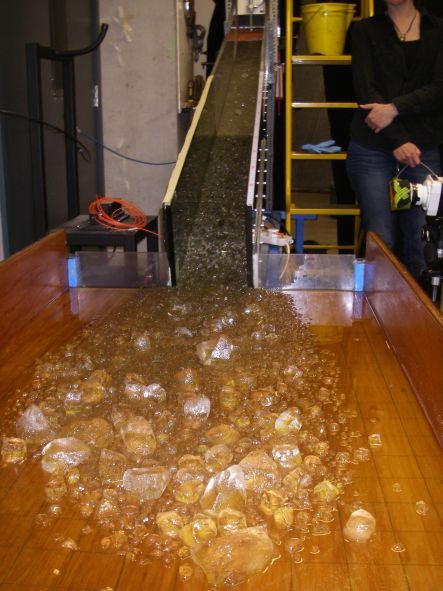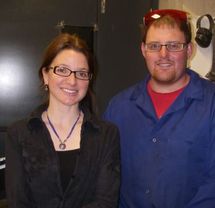
This simulation of a debris flow took a week to set up and eight seconds to run. It shows a normal debris flow, where large 'boulders' travel in front and spread out across the level fan at the end of the slope, while smaller 'rocks' spread out up the slope (image: A. Ballance)
Elisabeth Bowman (below left) is a geotechnical engineer in Civil and Natural Resources Engineering at the University of Canterbury. She is interested in understanding land movements, and how sand and mud move and behave under different conditions, depending on the slope and degree of saturation.
 She is particularly interested in debris flows, which are a highly unpredictable hazard in areas of mountainous terrain and high runoff. They are one of the most frequent mass movement processes, made up of high-speed gravity-driven mixtures of soil, rock, and water moving down a channel such as a gully. Mechanically, debris flows are particularly complex because they have a large range of clast sizes, from boulders through to silt. The most famous debris flow in New Zealand happened at Matata (PDF) near Whakatane in 2005, following very intense heavy rainfall, causing more than $10 million dollars worth of damage to houses and roads.
She is particularly interested in debris flows, which are a highly unpredictable hazard in areas of mountainous terrain and high runoff. They are one of the most frequent mass movement processes, made up of high-speed gravity-driven mixtures of soil, rock, and water moving down a channel such as a gully. Mechanically, debris flows are particularly complex because they have a large range of clast sizes, from boulders through to silt. The most famous debris flow in New Zealand happened at Matata (PDF) near Whakatane in 2005, following very intense heavy rainfall, causing more than $10 million dollars worth of damage to houses and roads.
To help understand what is happening during a debris flow Master's student Josh Bird has been modelling them in the lab using different sized glass pebbles in a thick oily liquid. He films the model flow with a high-speed camera and laser so he can analyse the behaviour of the flow. Alison Ballance meets Elisabeth and Josh to observe one of these mini debris flows in action, which take one week to set up and run, and last just eight seconds. This research project is part of a Marsden grant called 'Investigation of the internal mechanics of debris flows’.

